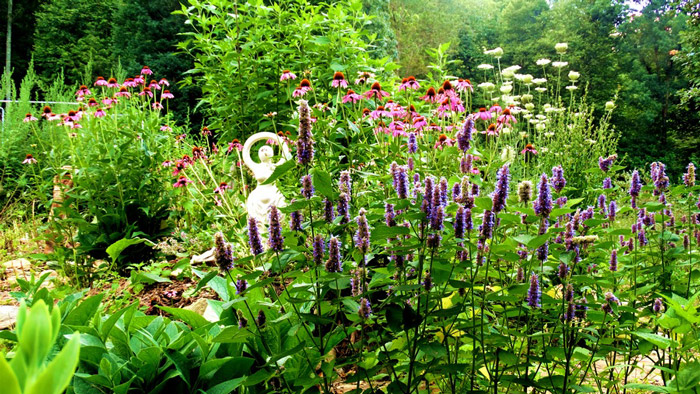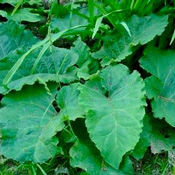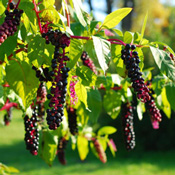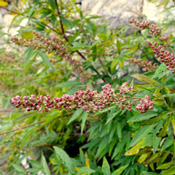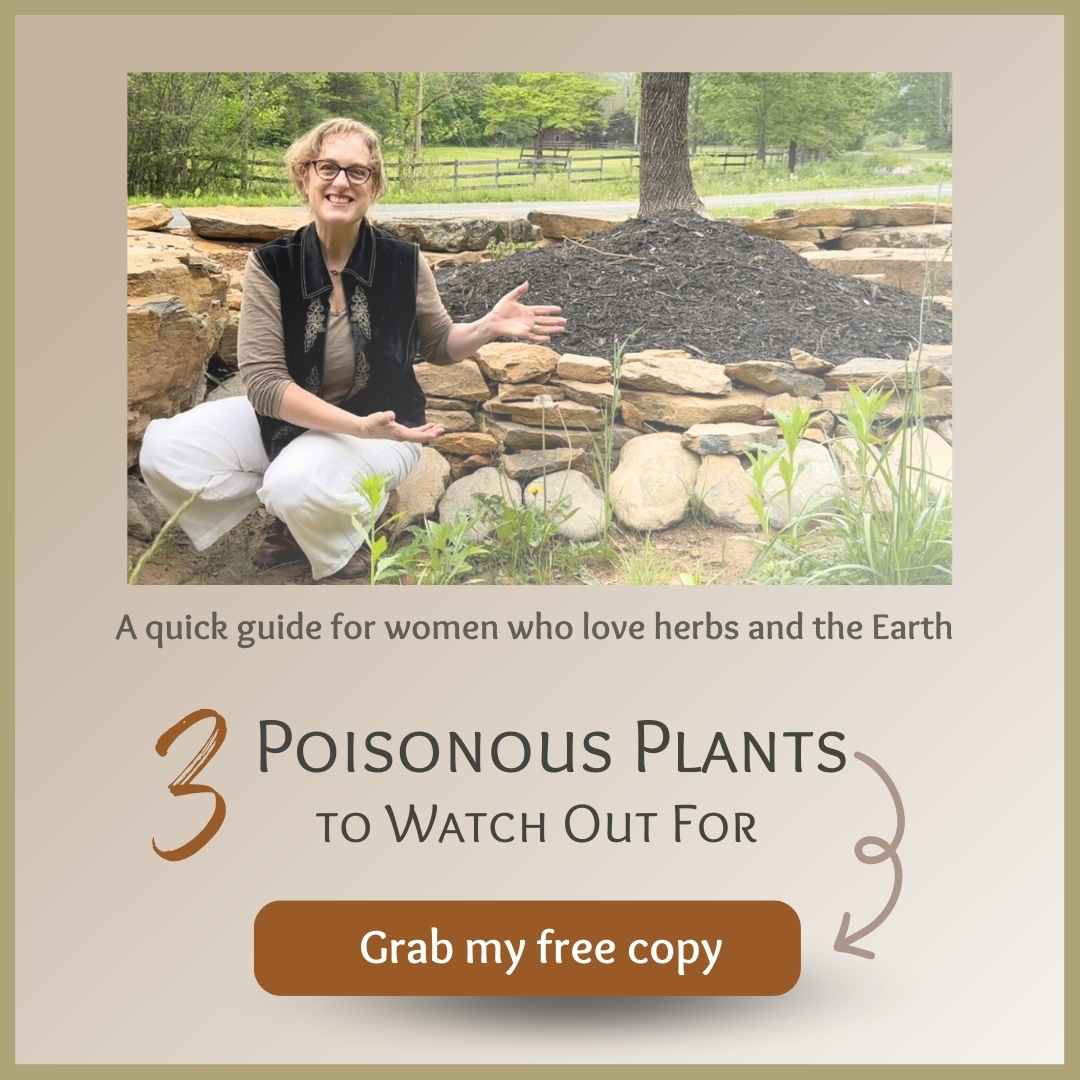Corinna's Online Guide to Wise Woman Herbal Medicine

by Corinna Wood
Wise woman herbal practices are your birthright. When you look far enough back, we all come from indigenous earth-based roots.
Wise women have long used folk medicine—tried-and-true home remedies that have sustained and healed for generations.
For health and healing, they looked no further than the plants that grew on their doorsteps and in the neighboring woods and fields for the ingredients used in their salads, soups, infusions, tinctures, and teas.
This knowledge was passed on from grandmother to mother to daughter.
I’ve compiled this guide about herbal medicine making the wise woman way to help you answer questions like . . .
- What’s the difference between an herbal tincture and herbal vinegar? How do I know when to use which method?
- What does a wise woman’s medicine chest contain?
- How do I know when to harvest certain herbs?
- How do I get to know the herbs around me better?
- What herbs will support me as a woman at various ages and stages?
I’ve been an herbalist in the Wise Woman Tradition for three decades. You might say I’m an expert on the subject.
For 20 years, I made medicines from common, local plants for women’s health at my herbal medicine company, Red Moon Herbs (until I passed the baton to Jeannie Dunn). Over the decades, I’ve taught hundreds of educational programs on herbs and women’s health, and I founded the renowned Southeast Wise Women Herbal Conference.
I trust you’ll find this guide helpful and inspiring. Let's dig in!
Table of Contents
- Wise woman herbal medicine making
- Wise woman herbal first aid kit
- Seasons of harvest
- Herbs for women of all ages and stages
- Summary
Wise woman herbal medicine making
In holistic healing for earth-based women, we first turn to common abundant herbs—the ones you find right in your backyard. The herbs that are often considered “weeds.”
We live in the same ecosystem as the plants around us—the same soil, the same air and the same water. As they thrive in that environment they can support our thriving as well.

Making medicines with herbs you find and identify in your surroundings is fun and easy to do.
The medicinal properties can be extracted in the form of infusions, tinctures, salves or oils, and vinegars. Or in my all-time favorite form: eating them fresh and unchanged in wild salads.
Let’s take a look at various methods you can use to extract the constituents (medicinal properties) from your favorite herbal allies.
Herbal infusions
 Infusions are a potent way to nourish and tonify your body on a daily basis.
Infusions are a potent way to nourish and tonify your body on a daily basis.
Think of infusions as strong herbal tea. A tea that is steeped for four hours or more. This allows you to extract nutrient-rich constituents like vitamins, minerals and chlorophyll.
How to make an herbal infusion
- Immerse one cup of dried herb in a quart (4 liquid cups) of boiling water.
- Place a lid on top and allow it to sit on the counter for at least four hours.
- After four hours (or more), strain the liquid and enjoy!
- Infusions can be stored in the refrigerator for up to three days.
My favorite herb for making into infusions is stinging nettle which is nourishing for the adrenals and the kidneys as well as the hormonal and immune systems. Drinking nettles over time supports sustained energy levels.
Another favorite herbal infusion is oatstraw which is nourishing for the nervous system and supports sleep. Or red clover, known as the queen of the blood purifiers, and supportive of the respiratory system.
A tip on an easy way to get to know the herbs: if you make infusions from just one herb at a time (sure, you could rotate through a few within a week!), you’ll get to know how they look and taste—and how each one feels in your body.
Herbal tinctures
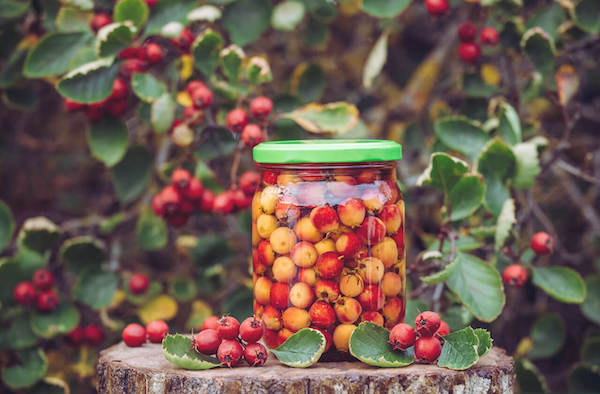 Tinctures are concentrated herbal extracts. Tinctures are my first choice for many first-aid situations and acute ailments.
Tinctures are concentrated herbal extracts. Tinctures are my first choice for many first-aid situations and acute ailments.
They're handy, quick and have a long shelf life when stored properly (3-5 years).
Tincturing an herb will extract the medicinal properties, which often include alkaloids. Alcohol is the most effective menstruum (liquid) for extracting alkaloids from the plant.
I make tinctures with 100 proof alcohol—which means it's 50% alcohol and 50% water. This extracts properties that are both water and alcohol soluble. You can use vodka, gin, whiskey or rum. Your choice!
Wondering exactly how to make a tincture? I’ve got you, sister! Read on . . .
How to make a tincture from fresh plants—the wise woman way
While you can make tinctures from dried herbs, in wise woman herbal medicine, I generally prefer fresh plants to maximize potency.
- Stuff a jar full with your plant material of choice—only one type of plant in a jar. Leave about 1/2" of headroom at the top.
- Fill the jar with alcohol and cap it with a lid.
- Top off your jar with alcohol as needed in the first few days and then again every week or so. Keep an eye on your jar for the first few days, and then again every week or so—it may need to be topped with alcohol.
- Let your herbal tincture steep for 6 weeks to allow the constituents to extract into the alcohol.
- After 6 weeks, strain out the plant material and pour your tincture into a dropper bottle.
- Amber glass will help prolong the life of your tincture—or at the least, keep your medicines out of direct sunlight.
A few examples of my favorite tinctures for long term health support include:
- Dandelion root to support the liver
- Hawthorn berry to nourish the heart and circulatory system
- Vitex berry for menopausal support
Herbal vinegars
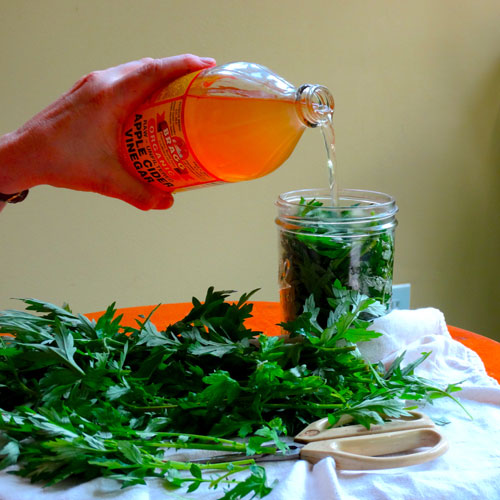 Making herbal vinegar is a method of extraction that's similar to herbal tinctures. In the case of herbal vinegars, the goal is to extract minerals from the wild plant. My understanding is that it's easier for your body to absorb and digest minerals in this form than from a tablet. And they're delicious as well as nutritious!
Making herbal vinegar is a method of extraction that's similar to herbal tinctures. In the case of herbal vinegars, the goal is to extract minerals from the wild plant. My understanding is that it's easier for your body to absorb and digest minerals in this form than from a tablet. And they're delicious as well as nutritious!
You can use herbal vinegars in salad dressings, on cooked greens, in marinades or sauces.
How to make wise woman herbal vinegars
- Fill a jar full of fresh plant material and then fill to the brim with raw apple cider vinegar.
- Seal the jar with a plastic lid. This is an important detail because the acidity of vinegar can cause metal to rust which can ruin the vinegar. If a plastic lid is not available, line the metal lid with a piece of wax paper.
- After six weeks, strain out the plant material. Place your herbal vinegar in a jar with a plastic lid—it will keep for 1-2 years.
Enjoy with your next salad, marinade or plate of cooked greens. Or try my recipe for garlic elixir vinegar, a tasty way to nourish and stimulate your immune system.
A few other herbs that I love to use in vinegars are chickweed, nettles or mugwort.
Herbal oils and salves
 Herbal oils are similar to tinctures and vinegars in that they are also concentrated herbal extracts. The difference is that the application of herbal oils is external (instead of internal), because the oil extracts "vulnerary" properties which heal the skin. The uses of herbal oils range from medicinal applications like burns, bug bites and scrapes to therapeutic applications like massage oil.
Herbal oils are similar to tinctures and vinegars in that they are also concentrated herbal extracts. The difference is that the application of herbal oils is external (instead of internal), because the oil extracts "vulnerary" properties which heal the skin. The uses of herbal oils range from medicinal applications like burns, bug bites and scrapes to therapeutic applications like massage oil.
Herbal oils are more difficult to make than tinctures and vinegars—because the medium of the oil itself can be prone to mold or rancidity with any excess moisture. So you need to be very attentive to reduce excess moisture when working with your fresh plants for herbal oils. Always harvest herbs for oils in dry weather—after the morning dew has evaporated, when there hasn’t been any rain for 48 hours.
Herbal salves are made from herbal oils—by melting in a thickening agent like beeswax, cacao butter or shea butter. For simplicity, I’ll assume you’re using beeswax, my favorite.
How to make wise woman herbal oils and salves
- Pack a jar full of dry (not dried ~ see above) plant material. Be sure that your jar and your hands are completely dry. This will reduce the likelihood of mold.
- Fill the jar to the top with the oil of your choice. I prefer extra virgin olive oil.
- Keep an eye on your jar the first few days and at least once a week after that—you'll probably need to top it off with oil several times.
- After 6 weeks, strain out the plant material and you’ve got your own herbal oil!
To turn this oil into a salve...
1. Warm the oil in a pot, over the lowest possible heat.
2. Gradually add beeswax until it’s completely dissolved.
Tip: If you grate the beeswax with a kitchen grater first, that will allow it to dissolve quickly—this helps to minimize the addition of heat (since heat degrades the oil).
3. Use one tablespoon of grated beeswax for every ounce of herbal oil. If you prefer to measure the beeswax with a scale, use a 1:7 ratio of beeswax (by weight) to oil (by volume).
4. Pour your melted concoction into salve jars. Have your salve containers clean, dry and ready because the salve will start to thicken as soon as you remove it from the heat.
5. If you find it's too thick, you can remelt and add more oil, or vice versa.
The best part is there's always enough left over in the pot to slather on your hands, face and arms . . . congratulations on your salve making!
Some of my favorite herbs to make into oils:
- St. Johnswort—or as I prefer to call her St. Joanswort—for sunscreen, massage oil or for calming the nerves
- Calendula for general skin nourishment and healing.
- Evergreen tree needles actually make an excellent oil for breast massage
My three favorite herbs to extract into oil for salve-making:
- Plantain for bug bites, scrapes and wounds
- Yarrow to speed wound healing and as a mild antibacterial
- Comfrey to promote rapid cell proliferation and for soothing and moisturizing (note: prior to making your oil, you'll need to partially wilt comfrey in a warm dry place for 12-24 hours, due to its high moisture content)
Wild salads
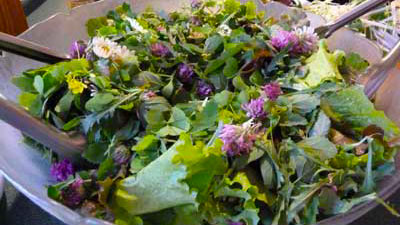
Wild salads are what inspired my interest in herbal medicine and nutrition in the first place!
I wanted to be able to look around my yard and know what I could eat. Making wild salads is a fun and nutritious way to expand your herbal knowledge.
Of course, it’s imperative to positively identify any wild edibles—as well as medicinals. Go slowly, starting with one at a time. When in doubt, consult one who knows.
When I gather leaves, I collect only the vibrant leaves near the top of the plant. Ensure that they are free of dirt so they can be added directly to your salad bowl once you get inside (you can rinse them, too, if that's your preference).
To make a simple wild salad, I usually pick one mild-tasting herb for the foundation--something like chickweed, violet or lambsquarter. Of course, it’s fine to mix in some fresh greens from your local farmer’s market or grocery store as well.
Then throw in some smaller quantities of plants like dandelion leaves, ox-eye daisy leaves, red clover flowers and any other strong-flavored wild edibles that you’re familiar with. You can garnish with violet and dandelion blossoms.
Wise woman herbal medicine making recap
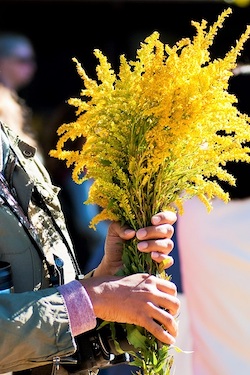
As a budding (or seasoned!) herbalist, you'll want a stock of wise woman’s herbal medicines close at hand. Making some of those yourself is deeply satisfying.
These folk methods are the foundation of medicine making the wise woman way—simple and potent.
When deciding which method to use, consider what type of constituents you want to extract and what purpose you have in mind. That will inform which menstruum you want to use (menstruum is a just a fancy word for the type of liquid into which you're extracting your herbal medicine).
- For drawing out minerals and other nutrients, water-based infusions or herbal vinegars are top choice. Infusions lend better to daily use as you can drink them like you would tea or water. Herbal vinegars are great for daily use as well but their sour taste may reduce the actual volume of consumption, therefore reducing the volume of nutrients you’re able to consume.
- For fast-acting medicinals to stock your medicine cabinets, alcohol-based tinctures and herbal oils are my first choice. Consider the application—external vs. internal—when choosing between these two.
Making your own medicines is a powerful act in itself. Herbs that are foraged fresh and harvested locally tend to be more potent than those shipped in by large companies from around the world.
So the "weeds" in your backyard, coupled with the experience of harvesting them yourself support a wholistic approach to healing.
Whether you're purchasing your herbal medicines or making them yourself, stocking your wise woman's herbal medicine chest is an essential step in shifting your reliance to more natural sources.
9 faves for your herbal first aid kit
Now that you know how to make your own medicines, let's look at top picks to have on hand.
The photo above is a glimpse of my "Goddess Garden," where I grow comfrey, echinacea, anise hyssop, and other other medicinal mints. So many herbs to love!
How to choose which faves to include in your medicine chest? Here are my 9 top first-aid herbs:
Echinacea, Echinacea purpurea/angustifolia, is a popular immune system stimulant and tonic. A fresh root tincture or infusion will support people with colds, flus, infections, sore throats or fevers.
Comfrey, Symphytum officinale, has a long history (and her-story) of external uses. As an herbal oil or salve, comfrey can treat eczema, cuts, scrapes, burns, scars, dry skin or chapped lips. There's a catch, though: You don't want comfrey to heal things over too fast! Be sure to clean your wounds diligently before using comfrey as a fresh herb poultice or oil/salve. For deep wounds, I recommend plantain (see below) over comfrey.
Motherwort, Leonuris cardiaca, is especially indicated for three common health issues for women: menstrual cramps, hot flashes and hormonal-related mood swings. She is also well known as an ally for the heart and circulatory system. Note: Motherwort, as a tincture, increases blood flow to the uterus so it is contraindicated for menopausal women with very heavy bleeding or flooding.
Osha, Ligusticum porterii, can be used to reduce allergic reactions (due to the risks of allergic reactions, when in doubt, always seek medical attention). Prepared as a fresh root tincture, this herbal medicine can also be taken to reduce the severity of asthma attacks if taken at the onset of symptoms.
Plantain, Platango major/lanceolata, is what my family uses as an over-the-counter antibiotic. Plantain is safe and effective in treating bee stings, cuts, bruises, bug bites, hemorrhoids and itchy skin. It’s also one of the most widespread “weeds” in lawns! The quickest application is to make a spit poultice by chewing up the leaf and putting it on the wound. Or just chop the plantain—or place it in a blender with a little water. Making plantain into an herbal oil or salve is a great way to keep her medicinal properties accessible year-round.
Poke Root, Phytolacca americana, as a tincture is a favorite in my community for sore throats, severe colds and respiratory infections. When applied externally as oil it can help reduce swollen lymph or dissolve lumps, bumps and growths.
St. Johnswort, Hypericum perforatum, aka St. Joanswort or St. J's as I fondly call her, can be made into a tincture to support people with depression. Helpful for people with seasonal affective disorder, St J's also has nervine and anti-viral properties. As an herbal oil or salve externally, St J’s is supportive for the nerves and as sunscreen. (Note: Internal use of St Johnswort is contraindicated for those taking birth control pills, as this herb can reduce effectiveness of the pill.)
Yarrow, Achillea millefolium, is known as a styptic, to stop bleeding. In addition to regulating blood, externally and internally, yarrow also helps prevent infection and has pain-relieving properties.
Wormwood, Artemisia absinthum, is my go-to for digestive distress such as stomach aches, food poisoning, amoebic dysentery, diarrhea and parasites. The fresh flowering tops are made into a tincture.
Stock your wise woman’s herbal medicine chest with these herbs to help prepare you for the day-to-day first aid needs that pop up. I know some of you are wondering about when you might harvest go out and harvest some these herbs yourself! In the next section, we’ll look at some of my favorite herbs from each of the seasons of harvest.
As you know, it's essential to positively identify any plants you're harvesting for food or medicine. First things first: Grab my free guide on 3 Poisonous Plants to Watch Out For (pdf) so you can stay safe on your herbal adventures.
Seasons of harvest
There are so many medicinal plants out there that it's easy to get overwhelmed! I encourage you to develop relationships with a small circle of herbal allies that can meet many of your herbal medicine needs. In this "seasons of harvest" section of the guide, I'll highlight some of my personal favorites.
Here’s a quick overview of which herbs to look out for in each of the seasons of harvest through the Wheel of the Year—as well as some identifying features and harvesting tips. As always when working with herbs, accurate identification is imperative—when in doubt, consult with one who knows. (And remember to keep an eye out for poison ivy—stay safe!)
Spring
 Chickweed, Stellaria media, is my favorite salad green. In spring, chickweed’s “star in the middle” shows white and bright with its four tiny white petals on each flower. Look for a line of hairs running along just one side of the stem. To harvest chickweed, just give the patch a little hair cut, snipping off the top few inches. You can harvest chickweed while in bloom—and even when it’s gone into seed. In fact, the seeds can make a tasty pesto!
Chickweed, Stellaria media, is my favorite salad green. In spring, chickweed’s “star in the middle” shows white and bright with its four tiny white petals on each flower. Look for a line of hairs running along just one side of the stem. To harvest chickweed, just give the patch a little hair cut, snipping off the top few inches. You can harvest chickweed while in bloom—and even when it’s gone into seed. In fact, the seeds can make a tasty pesto!
 Motherwort, Leonurus cardiaca, is in the mint family, even though she tastes bitter (some say like chocolate!). Like all plants in the mint family, motherwort has a square stem, opposite leaves and double lipped flowers. However, her leaves are maple-shaped. Like most of the medicinal mints, the best time to harvest motherwort is in her early flowering stage.
Motherwort, Leonurus cardiaca, is in the mint family, even though she tastes bitter (some say like chocolate!). Like all plants in the mint family, motherwort has a square stem, opposite leaves and double lipped flowers. However, her leaves are maple-shaped. Like most of the medicinal mints, the best time to harvest motherwort is in her early flowering stage.
 Nettles, Urtica dioica, and her cousin wood nettle, Laportea canadensis, resemble large mints with serrated, blue-green opposite leaves. The leaves, stem and roots are covered with minute hairs which trigger the release of formic acid—hence the reputation for stinging. This feature makes her easy to identify! Snip the tops for soup (or the top third of the plant for drying or vinegars). Don’t consume nettle after she starts flowering.
Nettles, Urtica dioica, and her cousin wood nettle, Laportea canadensis, resemble large mints with serrated, blue-green opposite leaves. The leaves, stem and roots are covered with minute hairs which trigger the release of formic acid—hence the reputation for stinging. This feature makes her easy to identify! Snip the tops for soup (or the top third of the plant for drying or vinegars). Don’t consume nettle after she starts flowering.
 Plantain Two species of plantain grow abundantly in North America: lance-leaved plantain (Plantago lanceolata) and broad-leaved plantain (Plantago major). They can be used interchangeably. The easiest way to identify both types is by their parallel veins running along the leaves. Most plants fork outward from a central midrib whereas plantain has side veins and a midrib which run parallel to one another down to the base of the plant. All parts of the plant are edible, including the seeds. You can harvest plantain from spring throughout the growing season.
Plantain Two species of plantain grow abundantly in North America: lance-leaved plantain (Plantago lanceolata) and broad-leaved plantain (Plantago major). They can be used interchangeably. The easiest way to identify both types is by their parallel veins running along the leaves. Most plants fork outward from a central midrib whereas plantain has side veins and a midrib which run parallel to one another down to the base of the plant. All parts of the plant are edible, including the seeds. You can harvest plantain from spring throughout the growing season.
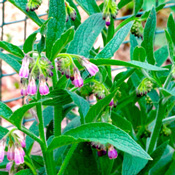 Comfrey, Symphytum officinale, grows quickly and can be harvested multiple times a year. First harvest is in mid-spring. Look for fuzzy (almost wooly) leaves and delicate pink, bell-like flowers that unfurl in spiral. Externally, comfrey is a powerful vulnerary (wound-healing) plant that promotes cell proliferation. To harvest, simply cut back the leaves after the plant reaches 12-18 inches tall. If you’re after the roots, wait until fall.
Comfrey, Symphytum officinale, grows quickly and can be harvested multiple times a year. First harvest is in mid-spring. Look for fuzzy (almost wooly) leaves and delicate pink, bell-like flowers that unfurl in spiral. Externally, comfrey is a powerful vulnerary (wound-healing) plant that promotes cell proliferation. To harvest, simply cut back the leaves after the plant reaches 12-18 inches tall. If you’re after the roots, wait until fall.
Summer
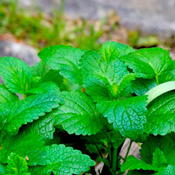 Lemon balm, Melissa officinalis, is a medicinal member of the mint family—with a square stem, opposite leaves and small white, double-lipped flowers. Add in the lemon-y fragrance, and she's easy to identify! That scent in itself is knows to lift the spirits. You'll gain similar benefits by just steeping the fresh herb as a tea for 10 minutes—while most herbs extract best into infusions brewed 4 hours or more, lemon balm's medicinal aromatic oils extract quickly into hot water. Harvest the leaves before and through the early to mid flowering stage.
Lemon balm, Melissa officinalis, is a medicinal member of the mint family—with a square stem, opposite leaves and small white, double-lipped flowers. Add in the lemon-y fragrance, and she's easy to identify! That scent in itself is knows to lift the spirits. You'll gain similar benefits by just steeping the fresh herb as a tea for 10 minutes—while most herbs extract best into infusions brewed 4 hours or more, lemon balm's medicinal aromatic oils extract quickly into hot water. Harvest the leaves before and through the early to mid flowering stage.
Mugwort, Artemesia vulgaris, aka crone wort is named after the moon goddess. A feathery perennial, her deeply divided, pinnate leaves are glazed on the underside with the signature silvery sheen evocative of the silver light of the moon. She also has a distinctive scent when the leaves are crushed which you can learn to recognize. Note: whenever using plants with deeply divided leaves like parsley or carrot tops, it is critical to be positive of the identification because of the risk of mistaking them for poison hemlock.
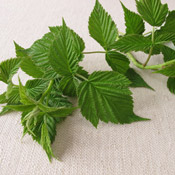
Red raspberry leaf, Rubus idaeus, is a garden variety raspberry plant and you may also find it growing in the wild. Raspberry leaves are in threes, with a sawtoothed edge, with grey/white on the backsides of the leaves. The best time to harvest the leaves is right before the plant begins to flower. Take just the leaves to dry for infusions and enjoy the berries as you pluck away. If you have a raspberry patch in your garden, cut the "suckers" which invade your paths in the spring. Watch out for her thorns!
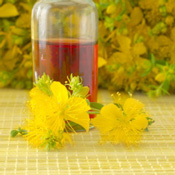 St. J’s, Hypericum perforatum, is truly lovely with five-petaled yellow flowers, small seed pods and delicate yellow-green leaves that blossom near the summer solstice. Hold a leaf up to the sun to look for the black dots which give it the name "perforatum," like perforations. They actually contain the dark red juice with the medicinal constituent hypericin. Peak potency for harvesting is when 1/3 of the flowers are blooming and the other 2/3 are still buds. Harvest the top third of the plant, including stalk, flowers and leaves. Both your brewing tincture and oil will turn red as the constituents infuse into your menstruum.
St. J’s, Hypericum perforatum, is truly lovely with five-petaled yellow flowers, small seed pods and delicate yellow-green leaves that blossom near the summer solstice. Hold a leaf up to the sun to look for the black dots which give it the name "perforatum," like perforations. They actually contain the dark red juice with the medicinal constituent hypericin. Peak potency for harvesting is when 1/3 of the flowers are blooming and the other 2/3 are still buds. Harvest the top third of the plant, including stalk, flowers and leaves. Both your brewing tincture and oil will turn red as the constituents infuse into your menstruum.
 Yarrow, Achillea millefolium, flowers early in spring and well into summer producing a flat-topped cluster of white flowers. She has feathery leaves and a tall slender stalk. Harvest the top third of the plant (flower, leaf and stalk) in the early to mid flowering stage.
Yarrow, Achillea millefolium, flowers early in spring and well into summer producing a flat-topped cluster of white flowers. She has feathery leaves and a tall slender stalk. Harvest the top third of the plant (flower, leaf and stalk) in the early to mid flowering stage.
Note: Yarrow has a very dangerous look alike, called poison hemlock, so you must be positive of the identification. One key difference between these two is in the stalk—look for purple splotches at the base of the stalk which is an indicator of poison hemlock. Another trick is that yarrow’s stalks will tend to be a bit fuzzy and hemlock is hairless. When in doubt, consult one who knows.
Fall
Fall is the most potent season of harvest for medicinal roots. As the plants prepare for dormancy over the winter, they send their energy below ground to the roots. (It's natural for you to feel called to slowing down with the season as well!) After the first frost, these are some of my favorite roots to dig for medicines.
Burdock, Articum minus/lappa, is a biennial plant so you’ll need to distinguish between first and second-year growth. Look for a purple thistle-like flower in summer that develops into brown burrs in fall. The large fuzzy broad leaves are somewhat triangular in shape with wavy edges and light colored undersides. To harvest, you'll need to dig a ring or trench around this herb as the taproot is very deep.
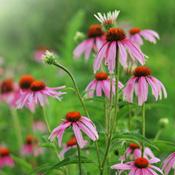
Echinacea, Echinacea purpurea/angustifolia, harbors her best medicine in the roots. Keep an eye out for a ray of purple petals surrounding a large central cone when she blooms in summer—and then come back in the fall to harvest the roots. As a perennial, echinacea roots grow more potent with age, so third-year plants are ideal for harvesting.
Poke, Phytolacca americana, is an herbal medicine to treat with caution. If you want to make medicine from poke, the roots are the preferred part of the plant to use. Identify poke by her purple berries peeking out in the late summer or autumn foliage—and then return in the late autumn/early winter to harvest the roots for medicinal use.
Wait to harvest until the aboveground portions of the plant have turned brown and fallen to the ground—that's when the medicinal properties are said to be at their highest and toxic properties at their lowest. Use the fresh root to make immune-boosting tinctures. Be sure to study up on how to use poke safely.
Vitex, Vitex-angus-castus, sometimes referred to as “chasteberry” is a shrub with beautiful, lavender colored cones of blossoms that butterflies love. Those blossoms develop into berries (left). In the mid to late fall, vitex's berries deepen to a rich deep brown color as they reach peak potency. Strip off the berries to gather the berries into a bag for extracting into an alcohol-based tincture.
Finding a plant ally—through the seasons
In general, I prefer to align myself with these backyard herbal friends over some of the more exotic, foreign, rare or endangered plants. A powerful way to learn about herbal medicine is to work with one plant ally over the course of a year. 
If you want to build a personal relationship with a plant ally, start by looking around. What plants do you see? I recommend choosing a plant that you frequently notice and start to observe how she changes over the seasons.
Learn the differences in her root, leaves and stem. Learn which parts are edible. Harvest and eat this plant ally in spring, summer and fall . . . notice how the tastes and flavors shift. Pay attention to how your body responds to the plant.
When you work intensively with one plant throughout the seasons, you gain knowledge of herbal medicine through hands-on experience. As you develop personal relationships with the plants around you, you build a circle of allies.
Herbs for women of all ages and stages
 As women, we have very specific needs during various phases of life. From menarche, menstruation and/or childbearing, through menopause and beyond.
As women, we have very specific needs during various phases of life. From menarche, menstruation and/or childbearing, through menopause and beyond.
On a physical level, we can find support our bodies through wholesome foods and nourishing herbs that encourage optimal health.
I’ve included a shortlist of herbs that support you through the various ages and stages of life.
Nettles, vitex, motherwort and comfrey make up my all-star cast of common herbs that support the needs of women that arise in various ages and stages—plus a few additional honorable mentions.
Menarche and menstruation
 Red raspberry leaf is rich in minerals and vitamins that can ease symptoms of PMS and menstrual cramps. Make red raspberry leaf infusion to nourish and strengthen your uterus as your body prepares for your moontime (menstruation)
Red raspberry leaf is rich in minerals and vitamins that can ease symptoms of PMS and menstrual cramps. Make red raspberry leaf infusion to nourish and strengthen your uterus as your body prepares for your moontime (menstruation)
Nettles are high in chlorophyll and iron, so this plant is very powerful for building blood and supporting you with period fatigue. She steadily nourishes the bones, the blood and the adrenals. Nettles acts as a mild diuretic, stimulating the kidneys to rid the body of excess water which helps reduce premenstrual bloating and breast tenderness. An infusion is most effective—a cup or more a day.
Vitex berry is useful in regulating the menstrual cycle to reduce PMS, return to regular cycles after getting off the pill, etc, or whenever the hormonal system is a bit wacky. Vitex is slow-acting, as a powerful long-term hormonal regulator—working through the pituitary gland, which in turn controls ovarian hormones. This is an ally to embrace for the long term and is best taken as a daily tincture.
Pregnancy and childbearing
Of course, not all women bear children—and we celebrate all the faces and choices of womanhood, mothers or not! If you or a loved one is looking for herbs to support fertility or pregnancy, check out these three of my favorites.
 Nettles for nourishing the blood especially around times of anemia, pregnancy, lactation, abortion or miscarriage. The high calcium content helps diminish pain during and after birth. A daily nettles infusion during pregnancy can ease leg cramps and after birth, it increases the richness and volume of breast milk.
Nettles for nourishing the blood especially around times of anemia, pregnancy, lactation, abortion or miscarriage. The high calcium content helps diminish pain during and after birth. A daily nettles infusion during pregnancy can ease leg cramps and after birth, it increases the richness and volume of breast milk.
Comfrey is a powerful ally for external use during pregnancy. Comfrey salve or oil can be used to improve the suppleness of breast and belly skin as it expands, minimizing stretch marks. It is also excellent for perineal massage in the last trimester to promote elasticity and prevent tearing during labor. While nursing, I found comfrey salve especially helpful in treating sore or cracked nipples (apply just after nursing).
Red raspberry leaf infusion eases morning sickness and can support fertility in women. Raspberry leaf strengthens the uterus which helps prevent miscarriage, and reduces pain during labor—by improving the strength of uterine contractions which can make birth easier and quicker.
Menopause
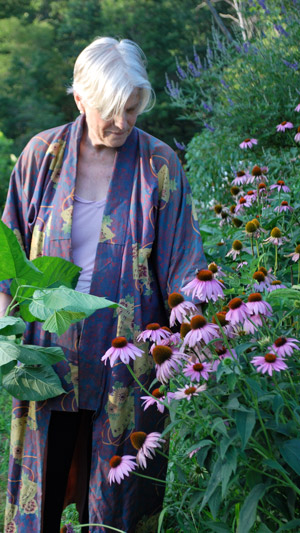 Nettles continue to be a valuable ally in menopause. The iron and chlorophyll help you avoid anemia and provide support during flooding (extreme heavy bleeding). Mineral-rich nettle infusions support the creation of new bone cells (called osteoblasts)—so coupled with weight-bearing exercise, nettles help you continue to build bone mass through menopausal years and beyond. Consume nettle daily as an infusion, in tea or in soups.
Nettles continue to be a valuable ally in menopause. The iron and chlorophyll help you avoid anemia and provide support during flooding (extreme heavy bleeding). Mineral-rich nettle infusions support the creation of new bone cells (called osteoblasts)—so coupled with weight-bearing exercise, nettles help you continue to build bone mass through menopausal years and beyond. Consume nettle daily as an infusion, in tea or in soups.
Vitex berry helps balance hormonal symptoms through the menopausal transition, including hot flashes, sleeplessness and heavy bleeding. The most effective method for receiving the medicinal properties of vitex is in a tincture. Although it can take three to six months before results are evident, they are deep and profound.
Comfrey in the form of an herbal oil or salve can ease vaginal discomfort by soothing, strengthening, and moisturizing the vaginal tissues—which can become thin, dry and susceptible to tears as we age. You won't want to miss this one!
Motherwort can take the edge and intensity off hormonal symptoms quickly—often within 20 minutes. As a fast acting complement to vitex, motherwort is useful in regulating hot flashes and hormonal mood swings—especially those that tend toward rage (if ya know what I mean!). Her medicine is best received in the form of a tincture. Note: motherwort is contraindicated for women who have heavy bleeding because of increased blood flow to the uterus.
Nourishing yourself from the inside out
Developing relationships with this small handful of beneficial herbs supports your health and wellness in a way that's in harmony with your body’s natural wholeness. Yet herbs are only one dimension of the myriad of wise woman self care ideas that support health and wholeness.
Beyond the physical benefits of nourishing herbs, the Wise Woman Tradition invites you to embrace the spiral of your life. That includes honoring both light and dark—and the upswing and downswing of your hormonal cycle.
Acknowledging your moontime as a window into your soul—and giving voice to your inner guidance—allows healing, integration and release. And as it turns out, I discovered that menopause is also a time ripe for inner work.
In the Wise Woman Tradition, we also consider nourishment as a practice that includes body and soul. Embodying women's power means reconnecting with your sacred body.
Wise woman herbal medicine for you
I encourage you allow your curiosity (or passion!) for herbal medicine to blossom organically—knowing it will ebb and flow.
To reduce overwhelm, getting to know one plant at a time can provide an in-depth understanding as you experiment with different constituents and techniques.
Of course, being able to effectively identify your edible and medicinal plants in the wild is an essential step in this journey.
When you notice wild plants in bloom, grab a plant identification field guide and begin familiarizing yourself with the plants around you.
Know that you can come back to this page on wise woman herbal medicine at any time.
Even with all the information at hand, the process of learning and integrating herbs into your life is like walking a spiral; you'll come back around to a similar place (herb, season, method), with new hooks to hang things on.
And remember, wild plants make wild women!
___________
Spread the wild wise woman ways! Link to this article from your website, or share with your friends using this button~
Comments ~ what stands out for you today?

